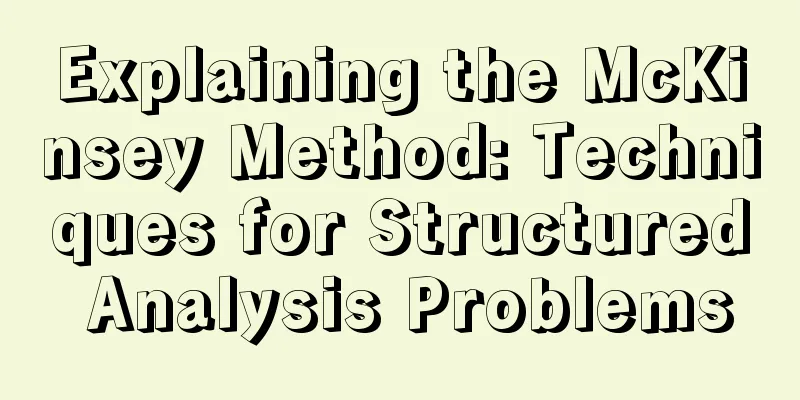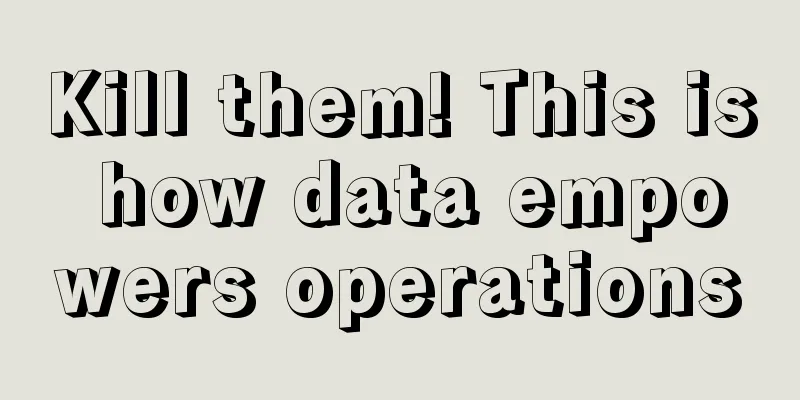Explaining the McKinsey Method: Techniques for Structured Analysis Problems

Many students are curious about whether there are any magical methods behind those high-end consulting companies. Some students also bought "The Pyramid Principle", but the book seems quite obscure. After reading it, many students only remember the opening: Food is divided into three categories: milk, fruit, and vegetables. However, what does this have to do with data analysis? How to conduct structured problem analysis? The whole book is very long, so today I will pick out the key points and share them with you in the most popular language. In fact, structured analysis is not just about "analysis". It includes three steps: sorting out the problem, analyzing the problem, and solving the problem. The saying "a good question is three quarters of a successful solution" is exactly this. 1. Sorting out the issuesWhen sorting out questions, the biggest taboo is: the answerer remembers whatever the questioner says. It is very likely that the other party only mentioned one aspect of the question and missed some information. If you want to sort out the questions in a systematic way, you can use the SCQA method. SCQA, namely:
Further, it can be divided into:
By sorting out and putting the problems together in specific scenarios, we can see clearly:
Let's take a simple example, a complete problem description, as shown below. In contrast, the most common question we hear is: "Why did DAU drop again?" This is a typical "three-no" question. However, many companies start their data analysis with such unclear questions, and then waste precious time in endless investigations, only to find out that:
Even before the analysis PPT was finished, the index went back up... ╮(╯▽╰)╭ Therefore, the first step in sorting out the problem is to ensure that S and C are clear enough. Common problems in real work are:
In short, the problem description is so incomplete that it is no wonder that you cannot form a hypothesis or find an evaluation criterion when doing analysis. Everyone should keep this in mind. 2. Analyze the problemWhen conducting an analysis, the most important distinction is whether there is an initial hypothesis! Having a hypothesis and not having a hypothesis are two completely different ideas. When there is no hypothesis, it is like looking for a needle in a haystack. You don’t know the root cause of the problem, nor do you know how to solve it. At this time, the only way to solve the problem is to use: benchmark analysis method.
This method is the most suitable for analysts to solve problems. Because analysts are strong in analysis but weak in execution. If you can find a suitable benchmark to copy directly, it will save analysts the process of learning the business, which is the most suitable. The disadvantages of this method are also obvious: slow, cumbersome, and empirical. It is very likely that the analyst will summarize for a long time and think that he has gained a lot, but in the eyes of the business, this is all "common sense" and "I knew it a long time ago." Moreover, not all problems can be benchmarked, and not all benchmarks are effective. Therefore, in general, the hypothetical method is more recommended.
This method can avoid the known business situation and get straight to the point. Moreover, from the perspective of analysis, it is easier to disprove than to prove, so the analysis conclusion can be formed faster. Of course, this method also has its disadvantages, which is that it requires the business to have sufficient understanding of the problem and be able to propose hypotheses. At the same time, it requires analysts to have strong enough logical ability to sort out the hypotheses. Because the hypotheses directly thrown to you by the business are likely to be self-contradictory and confusing... (as shown below) At this time, you need to use the MECE analysis method to sort out the logic of the problem. There have been similar sharings before. If you are interested, click: What is the MECE analysis method used by McKinsey? 3. Problem SolvingAfter the analysis is completed, you can start to solve the problem. Note! Not all the time, the business department is helpless. It is possible that they have a response plan. Therefore, if you want to solve the problem, you must first know the working status of the business department. There are four basic states:
In these four states, the ideas for solving problems are different. Obviously, the most difficult state is state 1, where you have no idea at all and can only look for ideas first. At this point, you can use the ideas you organized in the analysis phase:
The second most difficult to solve is state 4. Knowing that solution XX is not feasible is also half an answer. At least it narrows the scope of exploring solutions and knows which solutions are definitely not feasible. The operation at this time is the same as that for state 1, using benchmark analysis or MECE analysis. Explore solutions The third most difficult problem is state 3. If there is a solution, check two points:
Among them, the feasibility check of the solution itself is relatively simple, and it can be quickly confirmed if you are familiar with the business. There are two basic methods to predict whether the solution can solve the problem: either look at historical data. If there are similar projects in history, the results at that time can be used as a reference. Or, do a test first to see if the effect meets expectations before promoting it on a large scale. After analysis, if the solution is feasible and can solve the problem, just implement it directly. If not, return to state 4 and explore other solutions. State 2 is the easiest to solve. There are three solutions. You can directly compare the feasibility and expected effects of the three solutions. Of course, it is very likely that the process of exploring solutions is not smooth sailing, but a cycle of: discovering clues-verification-failure-rediscovery. Therefore, the above analysis process may be repeated for multiple rounds until the results are satisfactory (as shown in the figure below). IV. SummaryFor a long time, people have had a deep misunderstanding about analytical work. They think that those who do analysis are immortals wearing Taoist robes, stepping on auspicious clouds, and having immortal auras and crane bones. They don’t need others to say much, they can get the answer just by counting with their fingers... It seems that people who can analyze do not need to do specific work or understand the details. On the contrary! Serious analytical work is based on very detailed analysis of problems, very detailed analysis of assumptions, and very detailed analysis of benchmarks. The more detailed the work is, the more real information is collected, and the closer to the truth it is. The work is done so detailed that people who don’t know much will ask, “Is it that important? Is it necessary? I think it’s enough!” Many high-quality analyses are based on rejecting the “good enough” assumption. The essence of doing analysis is like a builder, who lays the foundation brick by brick. He is not a fortune teller. Remember this. However, there is another trend today, which is to treat algorithms as magical tools. People always think that as long as they input a few simple data, the algorithm with boundless power can produce super-powerful business insights... Author: Down-to-earth Teacher Chen; WeChat public account: Down-to-earth Teacher Chen |
<<: AI is the first to liberate the productivity of emotional consultation
>>: Taobao Live goes back to its rookie ways
Recommend
Just after the Spring Festival, video accounts started to grab traffic
After the Spring Festival, the battle for traffic ...
Read pure love on Xiaohongshu, and identify scumbags on Douyin
Follow the sweet pure love stories on Xiaohongshu,...
Even though it has earned $500 million, why is Xiaohongshu still not happy?
What are the pain points of Xiaohongshu's comm...
New features launched in iOS 17.3: New protection for stolen devices, even if you know the password
iOS17.3 has launched a new feature, adding the &qu...
How to evaluate the effect of Xiaohongshu after publishing
How does Xiaohongshu evaluate the results of its a...
Is it easy to run a cross-border e-commerce platform in Africa? What is it suitable for?
Cross-border e-commerce is developing very rapidly...
Can I get my deposit back for Shopee's activities? What are the advantages?
Everyone knows the Shopee platform. Now everyone w...
This generation of young people who love health care are promoting healthy consumption
The phenomenon of "crispy young people" ...
How many Wish accounts can one person register? What should I do if my Wish account is linked?
Wish is a relatively well-developed cross-border e...
Is exchanging RMB for foreign currency settlement or purchase of foreign exchange? What is the difference between the two?
In international trade and travel, the exchange of...
Fenghua’s 79-yuan meal set is selling out. How can old domestic brands retain traffic after the carnival?
This article will introduce the precise marketing ...
Can I apply again if I failed to register on Shopee? Why did I fail to register?
The Shopee platform has some requirements for sell...
New Hope’s private domain analysis shows that customer acquisition has increased 10 times, with a repurchase rate of up to 50%. How do fast-moving consumer goods brands play in the private domain?
This article takes the New Hope Dairy Company, whi...
How to calculate import tax refund for cross-border e-commerce? How to calculate tax?
With the advent of globalization and digitalizatio...
Young people who refuse to apply for credit cards have begun to "rectify" the consumer market
The consumption concept of millennials is changing...









